Easter is among just a handful of occasions throughout the year where families gather to celebrate together. From egg hunts that appeal to adults and children alike, to crafts to, cheeky chocolate treats; all families have their own celebratory traditions. One thing many have in common though, is a sit-down meal. After all, nothing sets off a much anticipated family get together like a good spread. For an occasion like Easter, you may be considering heading out to a restaurant or your local pub for a traditional Sunday roast. With this cook-at-home menu, though, you’ll serve up a restaurant quality Easter lunch at supermarket prices!
How we made our Easter lunch menu
We’ve based our menu around traditional dishes to have for Easter lunch, and a meat-free alternative for each course. Lamb is traditional – and seasonal – at Easter, never mind tasty, so that’s the foundation of our main. Then, we picked flavours that complement a gamy, fatty meat to set it up with a starter, accompany it as a main, and round it off as a dessert. We also thought about how complicated each of our selections is to make. When you’re cooking for a crowd, the last thing you want is three complicated dishes to contend with. Much better to do a few simple things well than attempt impressive culinary feats, only to fall short of expectations.
If lamb isn’t to your taste, you could swap a roast chicken into our Easter lunch menu without changing anything else. The dishes we’ve picked work deliciously with either meat.
The starter
Asparagus wraps with lemon mayo (BBC Good Food) – £1.18 per serving
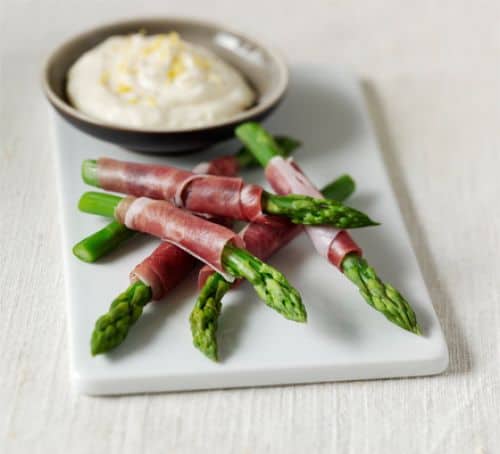
Image courtesy of BBC Good Food
When you have a roast to prepare, a simple, light starter than you can make ahead of time is a weight off your mind – and oven. Asparagus is usually just coming into season around Easter, making it the perfect precursor to equally seasonal spring lamb.
What you’ll need:
20 asparagus tips
5 slices of Parma ham
200ml light mayonnaise
The zest and juice of 1 lemon
How to make it:
Bring a pan of salted water to the boil, and tip in the asparagus.
Cook the asparagus in the boiling water for 2 minutes until just about tender, then drain well.
While the asparagus is cooking, slice each piece of parma ham into 4 shorter strips.
Wrap one piece of ham around each asparagus spear.
Mix the mayonnaise with the lemon zest and juice, and a little black pepper to taste. Serve with the asparagus for dipping.
Vegetarian alternative: Spiced beetroot and feta tarts (BBC Good Food) – £3.13 per tart
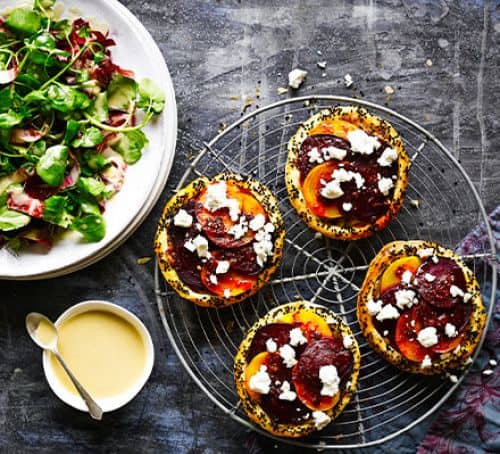
Image courtesy of BBC Good Food
This vegetarian starter takes a bit longer to prepare, but you could make the tart filling the day before to save you some prep time on the day of your Easter lunch. The warming spices and sharp feta mean it works both for those who prefer a meat-free dish, or those who simply don’t fancy asparagus before their lamb.
What you’ll need:
750g beetroot (about 6 beetroots), scrubbed and trimmed but not peeled
4 garlic cloves
4 tablespoons of olive oil
2 teaspoons of coriander seeds or ground coriander
2 teaspoons of cumin seeds
5 onions, peeled and finely diced
320g ready-made, pre-rolled all-butter puff pastry
1 tablespoon of harissa paste
2 teaspoons of sherry vinegar
1 egg, beaten,
100g vegetarian feta, crumbled
How to make it
First, heat your oven to 200 degrees. Rub the beetroot and garlic with a little olive oil, then wrap in a double layer of foil. Add about 100ml water to the foil parcel, then place in an ovenproof dish and bake for 2 hours. The beetroot should be tender – test it with a skewer or by inserting a sharp knife. Leave the beetroot to cool enough that you can handle it comfortably, then gently rub off the skins. Save the garlic cloves for later.
If using coriander seeds, toast these in a small frying pan until they start to release their fragrance, then grind with a pestle and mortar. Using ground coriander means you can skip this. Then, toast the cumin seeds and add them, whole, to the ground coriander.
In a larger frying pan, heat 3 tablespoons of olive oil, then add the onions and toasted spices. Cook very gently on a low heat for 30 minutes until the onions are soft and golden.
Locate the garlic cloves you baked with the beetroot earlier, and carefully squeeze them out of their skins. Stir them into the onions. Set the onion mixture aside until you’re ready to assemble your tarts.
Unroll the pastry and cut out 4 circles using a 12cm cookie cutter (or use a sharp knife to cut around a bowl or small plate). Place each circle on a baking sheet lined with grease-proof paper. Carefully score a 1cm border around each pastry circle – you don’t want to cut all the way through. Prick the centre of each disc with a fork, then bake in the oven (still at 200 degrees) for 10-15 minutes.
While the pastry cases are in the oven, mix the harissa paste, vinegar and remaining olive oil in a small bowl, and thinly slice the beetroot.
When the pastry cases come out of the oven, carefully flatten the middle area of each case with the back of a spoon. Dollop equal amounts of the onion mixture you made earlier into each pastry case and spread it into an even layer. Then, layer over the beetroot slices in a circular pattern, overlapping them slightly. Brush the harissa mix onto the beetroot, and then brush the border of each tart with the beaten egg. Bake the tarts in the oven for a further 12-15 minutes until the pastry is golden.
Sprinkle the crumbled feta over each tart, and serve with a small green salad.
The main course
Roast leg of lamb with minted Jersey Royals and peas (Great British Chefs) – £7.15 per serving
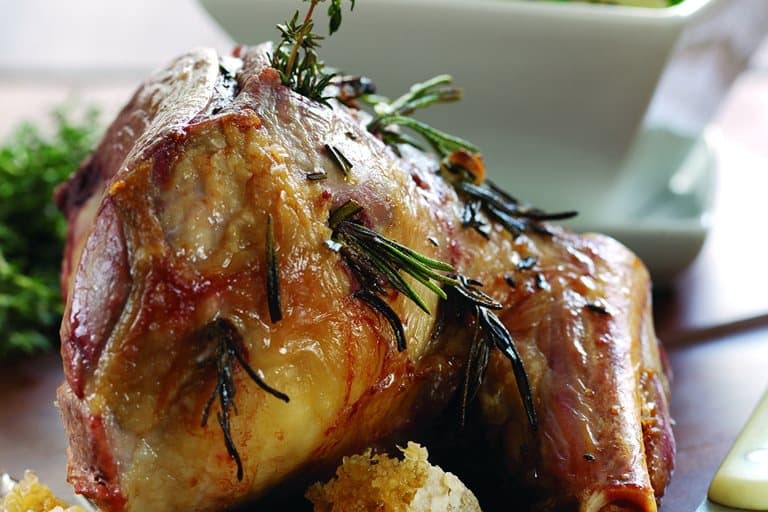
Image courtesy of Great British chefs
Remember what we said about avoiding complicated dishes for Easter lunch? Well, this roast lamb with minted potatoes by Shaun Rankin is simplicity at its best. You can more or less throw the lamb in the oven and forget about it until its cooked. What more could you want from a main when you’re entertaining?
What you’ll need
A 2 kilogram leg of lamb
3 sprigs of rosemary
3 sprigs of thyme
4 garlic cloves, roughly sliced
Salt and pepper
450g Jersey Royal potatoes
5 sprigs of mint
500g frozen garden peas
85g butter
How to make it
Pre heat the oven to 250 degrees – this is as hot as many ovens will go!
Snip the rosemary and thyme into smaller sprigs. Use a small knife to pierce six or seven holes in the lamb. Stuff each hole with a bit of rosemary, a bit of thyme, and a bit of garlic.
Season the lamb with salt and pepper and roast in the oven for about an hour, or until cooked to your liking.
When the lamb comes out the oven, it’ll need about 20 minutes to rest before you serve it. While it’s resting, cook the Jersey Royal potatoes in boiling salted water with three of the mint stalks. They’ll need about 15 minutes to become tender.
In a separate pan, cook the frozen peas in boiling water for a few minutes until tender and hot.
Chop the remaining mint and mix it together with the freshly cooked Jersey Royals and the butter. Serve slices of the lamb with generous portions of potatoes and peas.
Vegetarian alternative: Squash and pistachio roast (Jamie Oliver) – £2.14 per serving
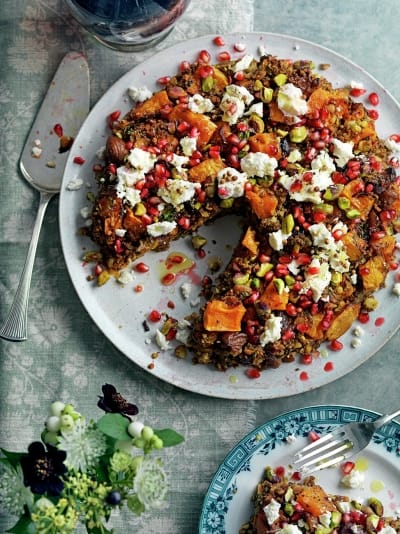
Image courtesy of Jamie Oliver
The bold Persian flavours in this nut roast make it a perfect follow-on from the beetroot and feta tarts started your Easter lunch with. It may seem like it uses a lot of ingredients, but many of them are spice cupboard staples that you’ll likely have already. You can top this roast with feta if you want, but as it features in the starter, we’d give it a miss so you don’t overload.
What you’ll need
400g squash, peeled, de-seeded and chopped into 1cm chunks
Olive oil
1 red onion, roughly chopped
1 small white onion, finely diced
2 fresh red chillies
4 cloves of garlic – two roughly chopped, two crushed
50g dried apricots, roughly chopped
50g sour cherries or cranberries, roughly chopped
2 teaspoons of cumin seeds
2 teaspoons of coriander seeds or ground coriander
The zest of 1 lemon
1 bunch of fresh coriander
1/2 a bunch of fresh thyme
200g tinned chestnuts, roughly chopped
1/2 teaspoon ground turmeric, plus a pinch
1 teaspoon ground cinnamon
1 stick of cinnamon
100g each of shelled pistachios and almonds
100g cooked brown rice
2 medium eggs
1 pomegranate
2 x 400g tins of plum tomatoes
1 tablespoon balsamic vinegar
How to make it
Pre-heat the oven to 180 degrees, and grease the bottom of a 24cm loose bottomed tart tin with a little olive oil.
Toss the chunks of squash onto a baking tray and drizzle with olive oil, salt and pepper. Roast for 20-25 minutes.
While the squash is in the oven, cook the red onion in a little oil for 10 minutes. Add the roughly chopped garlic and cook for another minute or so. Then, add the cumin, coriander, turmeric and ground cinnamon with a little more oil. Cook for a couple of minutes until you can smell all the spices.
In a food processor, blitz the pistachios and almonds until they’re ground to a coarse powder. Tip into a bowl with the cooked rice and add the lemon zest, fresh coriander and chestnuts. Beat and stir in the eggs and the onion spice mixture.
When the squash comes out the oven, set half aside, and mash the remaining half. Then, add both types of squash to your nuts, rice and onion mixture.
Spread the mixture into the tart tin you prepared earlier and press it down to flatten. Bake in the oven for about 3/4 of an hour until set.
Now your tart’s in the oven, you must be wondering what the other ingredients were for. Tomato sauce! Heat a little oil in a large saucepan. Prick the chillies and add to the pan with the cinnamon stick, thyme, pinch of turmeric, white onion and crushed garlic.
Cook for a minute or two, then add the two tins of plum tomatoes. Fill one tin with water and pour that in too, and give everything a good stir. Season with salt, stir through the balsamic vinegar, and bring to the boil. Turn down the heat and simmer for 20 minutes. Once the sauce is thick and glossy, pick out the chilli, cinnamon and thyme.
When the tart comes out the oven, carefully remove it from the tin and place it on a serving platter. Serve up for Easter lunch in big wedges, sprinkled with pomegranate seeds, with the tomato sauce on the side.
The dessert
Lemon pavlova (Nigella Lawson) – £0.92 per serving
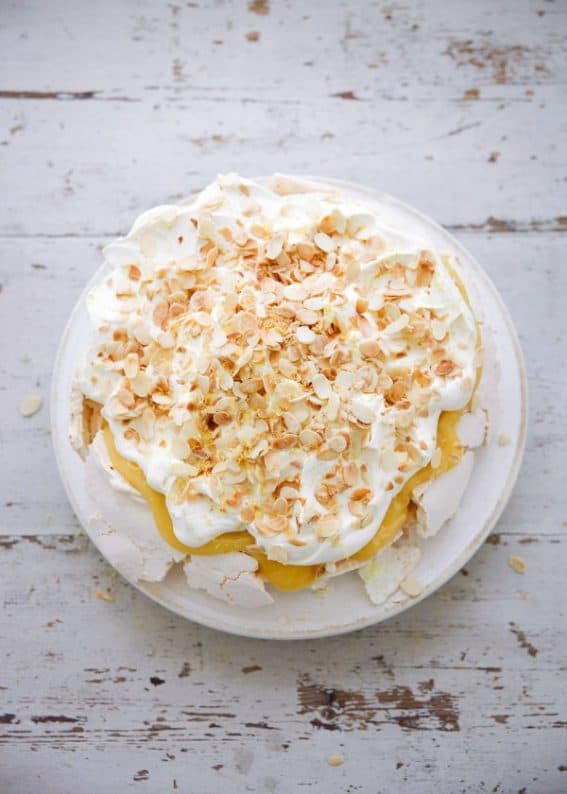
Image courtesy of Nigella Lawson
The beauty of a pavlova is that it doesn’t need to be pristine to be appealing. The sweet, light meringue and tart lemon combined with crunchy almonds will complement the flavours of your other courses and round off your Easter lunch perfectly. Plus, you can make the meringue ahead of time and pile it up with the filling right before you serve!
What you’ll need
6 egg whites
375g caster sugar
2 1/2 teaspoons of cornflour
2 lemons
50g flaked almonds, toasted. You can do this by dry frying them in a pan until they start to colour
300ml double cream, whipped
325g lemon curd (from a jar)
How to make it
Pre-heat your oven to 180 degrees and line a baking tray with grease-proof paper.
Beat the egg whites (with an electric whisk if you have one) until they form peaks with a satin-y look to them. Then, beat in the sugar, a spoonful at a time, until the meringue is stiff and shiny.
Sprinkle the cornflour over the meringue, then add the zest of one lemon and two teaspoons of lemon juice. Gently fold the meringue until everything is thoroughly mixed together. Dollop the mixture onto the lined baking tray in a fat circle – it should be about 23cm in diameter. Smooth the sides and top with a knife or spatula.
Place the meringue in the oven, then immediately turn the temperature down to 150 degrees – meringue doesn’t like a hot oven – and cook for an hour. When it’s done, remove it from the oven and leave it to cool. Don’t put it in the fridge straight away, though, as this will make the meringue crack too quickly. You could leave it in the oven with the door open.
When you’re ready to eat, turn the meringue out onto a serving plate, so the underside is now on the top. Spread the lemon curd over the meringue base with a spatula, then heap the whipped cream on top. Sprinkle with the zest of the remaining lemon and the toasted almonds.
Serve immediately.
Who needs Easter eggs when you have this Easter lunch menu? Enjoy!



















